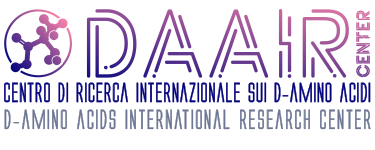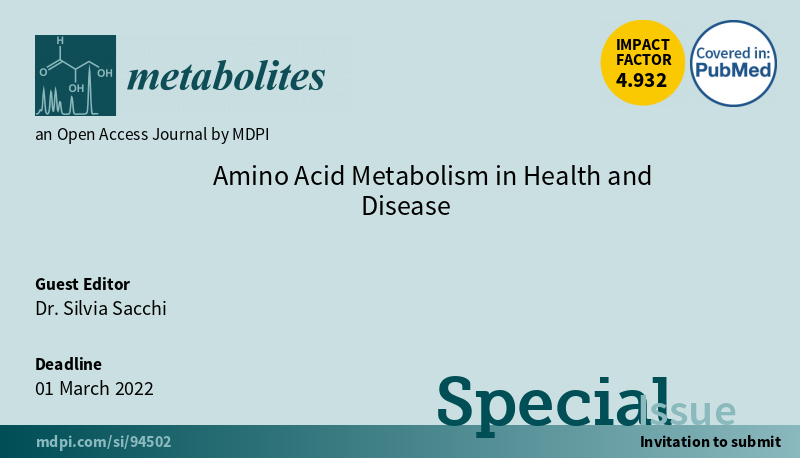
Do you have news concerning the D-amino acids field to announce? Is there a relevant published paper to mention? Write us and take the advantage of this bimonthly Newsletter.

A message from Jonathan Sweedler, Chair IDAR2022
Dear friends,
I am happy to announce one of the most significant and exciting D-Amino Acid events of 2022. The plans for the Fifth International Conference on D-Amino Acid Research — IDAR2022 — are moving ahead after IDAR2021 was postponed due to the pandemic. IDAR22 will be held July 25-28th, 2022 at the Beckman Institute, University of Illinois, Urbana IL USA. IDAR2022 follows on successful past meetings and continues the tradition of presenting the most exciting research and developments in the fields of D-Amino Acids. The meeting will consist of four days of exciting keynote talks from international leaders as well as contributed talks, posters, fun social events, and much more. The major sessions will include:
• Analytical methods for D-amino acid characterization
• Central Nervous System and peripheral organ diseases related to D-amino acids metabolism (nervous system, kidney, intestinal physiology and pathology, infectious diseases, etc.)
• D-AAs in plants, microbiota and the environment.
• D-Amino Acids in pharma and biotechnology
• D-Amino acid containing peptides / proteins
• Unusual D-Amino Acids (looking beyond D-Ser and D-Asp)
• D-Amino acids in nutrition and diet
• Physiology and metabolism of D-AAs
I am looking forward to reconnecting with the D-AA community and hope to see you next July. Please feel free to contact me with any questions, ideas or to added to the conference email list.
Thanks,
Jonathan Sweedler, Chair IDAR2022
On behalf of the International Scientific Committee
IDAR2022.USA@gmail.com


OBITUARY:
Professor Mirella Pilone, the founder of the laboratory of biochemistry at Varese (Italy), passed away at the age of 84 years on October 2021. She was a pioneer in the D-amino acids fields: her studies focused on D-amino acid oxidase and on biotechnological applications of D-amino acids. Mirella Pilone made unique and long-lasting contributions to our understanding of this field. Apart from science, travelling was her passion. All the researchers in Varese, and some researchers around the world, are indebted to her.
Dear colleagues, if you are willing to contribute to the special issue “Amino Acid Metabolism in Health and Disease” in the journal “Metabolites” (see the banner here below), do not hesitate to contact me at silvia.sacchi@uninsubria.it

The Editor’s pick selection of the most intriguing papers is highlighted in yellow.
D-AAs AND PHYSIOLOGY:
- D-cysteine is an endogenous regulator of neural progenitor cell dynamics in the mammalian brain
Semenza ER, Harraz MM, Abramson E, Malla AP, Vasavda C, Gadalla MM, Kornberg MD, Snyder SH, Roychaudhuri R.
Proc Natl Acad Sci U S A. 2021 Sep 28;118(39):e2110610118. doi: 10.1073/pnas.2110610118
Cysteine is the amino acid with the fastest spontaneous racemization rate in vitro. In this paper endogenous D-Cys was analyzed in the mammalian brain and serine racemase (SR), a candidate biosynthetic enzyme for D-Cys, was reported to be 20-fold enriched in the embryonic mouse brain compared with the adult one. D-Cys reduces the proliferation of cultured mouse embryonic neural progenitor cells (NPCs) by ∼50%; the antiproliferative effect is mediated by the transcription factors FoxO1 and FoxO3a. The selective influence of D-Cys on NPC proliferation is reflected in overgrowth and aberrant lamination of the cerebral cortex in neonatal SR knockout mice. Indeed, myristoylated alanine-rich C-kinase substrate (MARCKS) was identified as a putative D-Cys-binding protein.
- Complexities of the chemogenetic toolkit: Differential mDAAO activation by D-amino substrates and subcellular targeting
Y. C. Erdogan, H. Y. Altun, M. Secilmis, B. N. Ata, G. Sevimli, Z. Cokluk, A. Ghaffari Zaki, S. Sezen, T. Akgul Caglar, İ. Sevgen, B. Steinhorn, H. Ai, G. Öztürk, V. V. Belousov, T. Michel, E. Eroglu
Free Radical Biology and Medicine, 177 (2021) 132-142, ISSN 0891-5849,
https://doi.org/10.1016/j.freeradbiomed.2021.10.023.
Here, D-amino acid oxidase (DAAO) was used to generate H2O2 on demand with a high spatiotemporal resolution by providing/withdrawing its substrates. A variant of DAAO (termed mDAAO, and originally produced by the team in Varese) with improved activity at low oxygen and D-amino acid concentrations, was used to generate H2O2 under hypoxic conditions and in different subcellular compartments, then imaged by the ultrasensitive H2O2 sensor (HyPer7). When mDAAO was used with the hydrogen sulfide sensor hsGFP, administration of D-cysteine to cells generated strong H2S signals. This investigation indicate mDAAO as a novel chemogenetic tool to investigate the role of ROS signaling pathways with high spatial and temporal precision.
- Glyoxylate reductase/hydroxypyruvate reductase regulates the free D-aspartate level in mammalian cells
Katane M, Matsuda S, Saitoh Y, Miyamoto T, Sekine M, Sakai-Kato K, Homma H.
J Cell Biochem. 2021 Nov;122(11):1639-1652. doi: 10.1002/jcb.30110.
In mammalian cells D-aspartate (D-Asp) is degraded by D-aspartate oxidase (DASPO or DDO) but little is known about the molecular mechanisms underlying its homeostasis. Here, a cell line that overexpresses cytoplasm-localized DASPO was established: this cell line cannot survive in the presence of high concentrations of D-Asp. These cells were transfected with a complementary DNA library derived from the human brain and were screened for clones that affected D-Asp metabolism and improved cell survival: a clone expressing glyoxylate reductase/hydroxypyruvate reductase (GRHPR) was identified. The GRHPR metabolites glyoxylate and hydroxypyruvate inhibited the enzymatic activity of DASPO. This interesting work demonstrated that GRHPR contributes to the homeostasis of D-Asp in mammalian cells.
D-AAs AND PATHOLOGIES:
- Nα-(5-Fluoro-2,4-dinitrophenyl)-L-leucinamide-Derivatized LC/MS/MS Analysis of Amino Acid Enantiomers in HepG2 Cells
Y. TAKANO, M. TAKAHASHI, M. KOBAYASHI, T. UEMURA, T. FURUCHI
Chromatography 2021, 42, 143-149. DOI: 10.15583/jpchrom.2021.014
The levels of D- and L-amino acids were assayed in HepG2 cells using the Nα-(5-fluoro-2,4-dinitrophenyl)-L-leucinamide (FDLA) chiral derivatization method for liquid chromatography-tandem mass spectrometry. D-Asp and D-Ser were detected in HepG2 cells and their culture medium: their levels increased over time during culture. Indeed, by using a D-aspartate oxidase inhibitor the concentrations of D-Asp and D-Ser increased compared to those in the control cells. The authors concluded that D-Asp and D-Ser are biosynthesized in HepG2 cells and that both D-amino acids are regulated by D-aspartate oxidase.
- Carbon dots confined in N-doped carbon as peroxidase-like nanozyme for detection of gastric cancer relevant D-amino acids
Z. Li, W. Liu, P. Ni, C. Zhang, B. Wang, G. Duan, C. Chen, Y. Jiang, Y. Lu
Chemical Engineering Journal, 428 (2022) 131396, ISSN 1385-8947, https://doi.org/10.1016/j.cej.2021.131396.
The authors started from the evidence that D-proline and D-alanine levels are higher in the saliva of early-stage gastric cancer patients compared to healthy people. Here, carbon dots confined in N-doped carbon (CDs@NC, acting as peroxidase-like nanozyme) were used for the colorimetric detection of D-amino acids. The results of saliva tests suggest that the colorimetric method could be used to quickly distinguish patients with early gastric cancer from healthy people.
- Computational Design of Potent D-Peptide Inhibitors of SARS-CoV-2
Valiente PA, Wen H, Nim S, Lee J, Kim HJ, Kim J, Perez-Riba A, Paudel YP, Hwang I, Kim KD, Kim S, Kim PM.
J Med Chem. 2021 Oct 28;64(20):14955-14967. doi: 10.1021/acs.jmedchem.1c00655
Blocking the association between the severe acute respiratory syndrome coronavirus 2 (SARS-CoV-2) spike protein receptor-binding domain (RBD) and its receptor, i.e. the human angiotensin-converting enzyme 2 (ACE2), is an attractive approach to prevent the virus from entering human cells. On this side, D-amino acid peptides offer unique advantages such as: serum stability, low immunogenicity, and low cost of production. Here, a potent novel D-peptide inhibitor that mimics the ACE2 α1-binding helix was designed by searching a mirror-image version of the PDB. The two best peptides bound the RBD with affinities of 29 and 31 nM and blocked the infection of Vero cells by SARS-CoV-2 with IC50 values of 5.8 and 6.6 μM, respectively, thus representing promising lead candidates for developing SARS-CoV-2 therapeutic treatments.
- Directly and Indirectly Targeting the Glycine Modulatory Site to Modulate NMDA Receptor Function to Address Unmet Medical Needs of Patients With Schizophrenia
Pei JC, Luo DZ, Gau SS, Chang CY, Lai WS.
Front Psychiatry. 2021 Oct 1;12:742058. doi: 10.3389/fpsyt.2021.742058
This review describes preclinical and clinical studies of direct and indirect glycine modulatory site (GMS) modulators of NMDARs in the treatment of schizophrenia, including glycine, D-cycloserine, D-serine, glycine transporter 1 (GlyT1) inhibitors, and D-amino acid oxidase inhibitors. Current findings suggest that indirectly targeting of GMS appears to be more beneficial and leads to less adverse effects than direct targeting of GMS to modulate NMDAR functions. Especially GlyT1 inhibitors and DAAO inhibitors seem well suited for the treatment of schizophrenia.
- D-Amino Acids and pLG72 in Alzheimer’s Disease and Schizophrenia
Cheng YJ, Lin CH, Lane HY.
Int J Mol Sci. 2021 Oct 9;22(20):10917. doi: 10.3390/ijms222010917
This review reports on the roles of D-amino acids and pLG72, also known as D-amino acid oxidase activator (although it was reported to inhibit DAAO) in schizophrenia and Alzheimer’s disease (AD). In details, the changes in D-amino acids levels, gene polymorphisms of G72 genomics, and the role of pLG72 on NMDARs and mitochondria in schizophrenia and AD were reviewed, as well as the clinical diagnostic value of D-amino acids and pLG72 and the therapeutic importance are also reviewed.
D-AAs AND BACTERIA:
- Epimers L- and D-Phenylseptin: How the relative stereochemistry affects the peptide-membrane interactions
V. H.O. Munhoz, C. S. Ferreira, L. O. Nunes, T. L. Santos, C. Aisenbrey, R. Adão, A. F. de Carvalho Alcântara, M. T.Q. de Magalhães, D. Piló-Veloso, J. M. Resende, B. Bechinger, R. M. Verly
Biochimica et Biophysica Acta (BBA) – Biomembranes, 1863(11) (2021) 183708, ISSN 0005-2736, https://doi.org/10.1016/j.bbamem.2021.183708.
The naturally occurring L-Phenylseptin (L-Phes) and D-Phenylseptin (D-Phes) peptides (FFFDTLKNLAGKVIGALT-nh2) were reported to show higher activity against Staphylococcus aureus and Xanthomonas axonopodis in comparison with the L-epimer. By a number of biophysical methods, the role of the D-phenylalanine in the increase of the antimicrobial activity was studied. The higher capability of D-Phes to exert an efficient anchoring in the hydrophobic core of the phospholipid bilayer indicates a pivotal role of the N-terminus in enhancing the interaction between the D-peptide and the membrane interface compared to its epimer.
- D-Serine induces distinct transcriptomes in diverse Escherichia coli pathotypes.
Connolly JPR, Turner NCA, Hallam JC, Rimbi PT, Flett T, McCormack MJ, Roe AJ, O’Boyle N. Microbiology (Reading). 2021 Oct;167(10). doi: 10.1099/mic.0.001093
D-Serine is considered a toxic metabolite present in highly variable concentrations at different colonization sites in humans; D-Ser was previously found capable of inducing changes in gene expression. In this study, the global transcriptional response of three E. coli pathotypes (i.e. enterohaemorrhagic E. coli EHEC, uropathogenic E. coli UPEC, and neonatal meningitis-associated E. coli NMEC) to D-Ser was reported to be highly distinct: results demonstrate distinct pleiotropic responses to a common metabolite in diverse E. coli pathotypes, with important implications for niche selectivity.
ENZYMES ACTIVE ON D-AAs:
- Ultrafast photoinduced electron transfer in o-aminobenzoate – D-amino acid oxidase complex
S. Taniguchi, H. Chosrowjan, H. Tamaoki, Y. Nishina, A. Nueangaudom, F. Tanaka
Journal of Photochemistry and Photobiology A: Chemistry, 420 (2021) 113448, ISSN 1010-6030, https://doi.org/10.1016/j.jphotochem.2021.113448
Absorption spectrum of o-amino benzoate (oAB)–D-amino acid oxidase complex (ODC) displays a well-known charge transfer (CT) band around 570 nm. Here, the fluorescence decays of the second lowest electronic state of ODC were measured: the observed ultrafast lifetimes are ascribed to the photoinduced electron transfer (PET) from the oAB to the excited isoalloxazine in the ODC. The PET mechanism in ODC was studied with Marcus-Kakitani-Mataga theory. Electrostatic (ES) energies between the photoproducts of donor-acceptor, and net ES energies between the photoproducts and ionic groups in the protein were calculated with MDS structures: ES energies were evaluated with charge densities of neutral radical of oAB produced after PET and anion radical of the isoalloxazine obtained by semi-empirical molecular orbital method. The authors discussed the transition dynamics among local excited states of isoalloxazine, CT state and the ion-pair state.
- Three-Dimensional Structure of Thermostable D-Amino Acid Transaminase from the Archaeon Methanocaldococcus jannaschii DSM 2661
Boyko, K.M., Nikolaeva, A.Y., Bakunova, A.K. T. N. Stekhanova, T. V. Rakitina, V. O. Popov, E. Yu. Bezsudnova
Crystallogr. Rep. 66, 802–807 (2021). https://doi.org/10.1134/S1063774521050035
Transaminases are involved in amino acid metabolism in all organisms. Here, the brief biochemical characterization of thermostable fold type I pyridoxal 5′-phosphate-dependent transaminase from the thermophilic archaeon Methanocaldococcus jannaschii DSM 2661 was reported. Its crystal structure was determined at 1.8 Å resolution and the structure of the functional dimer of the enzyme was compared with those of the close homologs.
D-AAs & BIOTECHNOLOGICAL APPLICATIONS:
- Colorimetric quantification of sodium benzoate in food by using d-amino acid oxidase and 2D metal organic framework nanosheets mediated cascade enzyme reactions
H. Zhang, H. Yang, P. Liu, X. Qin, G. Liu
Talanta, 237 (2022) 122906, ISSN 0039-9140, https://doi.org/10.1016/j.talanta.2021.122906
D-amino acid oxidase (DAAO) and 2D metal organic framework (2D MOF) nanosheets were used to set up a rapid colorimetric method for detecting sodium benzoate in food products. The 2D MOF nanosheets served as high efficient nanozyme with peroxidase-like catalytic activity and aimed at catalyzing the color reaction between hydrogen peroxide and 3,3’,5,5′-tetramethylbenzidine. Sodium benzoate acts as a competitive inhibitor of DAAO thus blocking H2O2 production. The assay was validated for sodium benzoate determination and showed a wide linear range (2–200 μM), low limit of detection (2 μM), high accuracy (recovery rate in 95.8–108%) and good selectivity. The method was used to analyze sodium benzoate concentration in juice, wine and vinegar.
- Highly selective synthesis of D-amino acids via stereoinversion of corresponding counterpart by an in vivo cascade cell factory
Zhang DP, Jing XR, Wu LJ, Fan AW, Nie Y, Xu Y.
Microb Cell Fact. 2021 Jan 9;20(1):11. doi: 10.1186/s12934-020-01506-x
Here, an in vivo biocatalytic system for the synthesis of D-amino acids from L-amino acids by the co-expression of membrane-associated L-amino acid deaminase from Proteus mirabilis (LAAD), meso-diaminopimelate dehydrogenases from Symbiobacterium thermophilum (DAPDH), and formate dehydrogenase from Burkholderia stabilis (FDH) was developed in recombinant Escherichia coli cells. Three strategies were evaluated to regulate enzyme expression levels: under optimal conditions, 75 mg/mL of recombinant E. coli whole-cell biocatalyst asymmetrically catalyzed the stereoinversion of 150 mM L-Phe to D-Phe, with quantitative yields of over 99% ee in 24 h, by adding 15 mM NADP+ and 300 mM ammonium formate. The same system was used to stereoinvert various aromatic and aliphatic L-amino acids to their corresponding D-enantiomers.
The D-amino acids International Research Center “DAAIR“ has been established in Gerenzano (Varese, Italy) in 2019 with the aim to support and perform scientific research projects and activities on the field of D-amino acids. The Center, located inside the Fondazione Istituto Insubrico Ricerca per la Vita, is aimed to represent a pole of excellence at international level for dissemination and research involving the D-amino acids (Director Silvia Sacchi).
The guiding principle is support the research projects aimed to investigate the involvement of D-amino acids in main physiological processes, from bacteria to humans. The ultimate goal is to actively participate to the elucidation of the mechanisms by which the D-amino acids perform specific functions, and to identify their presence and concentration in different organisms and compartments, also with regards to well-established functional states, with particular emphasis to pathological states. Understand the involvement of D-amino acids in important diseases as a way to set up novel therapeutic strategies.
Contacts: info@d-aminoacids.com;
director@d-aminoacids.com;
www.d-aminoacids.com
https://www.d-aminoacids.com/
mailing address: info@d-aminoacids.com
Commenti recenti